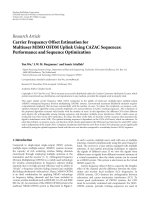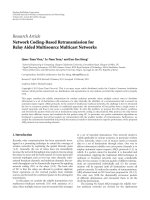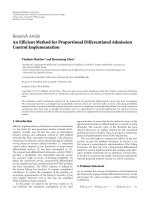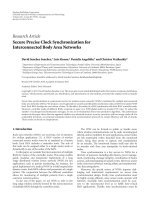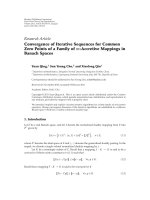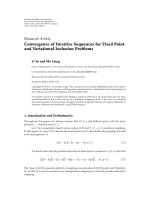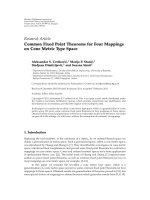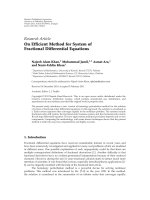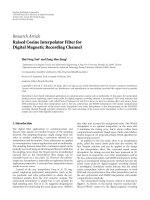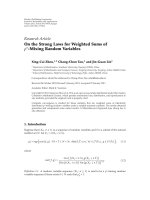Báo cáo hóa học: " Research Article Non-Constant Positive Steady States for a Predator-Prey Cross-Diffusion Model with Beddington-DeAngelis Functional Response" pot
Bạn đang xem bản rút gọn của tài liệu. Xem và tải ngay bản đầy đủ của tài liệu tại đây (624.1 KB, 26 trang )
Hindawi Publishing Corporation
Boundary Value Problems
Volume 2011, Article ID 404696, 26 pages
doi:10.1155/2011/404696
Research Article
Non-Constant Positive Steady States for
a Predator-Prey Cross-Diffusion Model with
Beddington-DeAngelis Functional Response
Lina Zhang and Shengmao Fu
Department of Mathematics, Northwest Normal University, Lanzhou 730070, China
Correspondence should be addressed to Shengmao Fu,
Received 13 October 2010; Accepted 30 January 2011
Academic Editor: Dumitru Motreanu
Copyright q 2011 L. Zhang and S. Fu. This is an open access article distributed under the Creative
Commons Attribution License, which permits unrestricted use, distribution, and reproduction in
any medium, provided the original work is properly cited.
This paper deals with a predator-prey model with Beddington-DeAngelis functional response
under homogeneous Neumann boundary conditions. We mainly discuss the following three
problems: 1 stability of the nonnegative constant steady states for the reaction-diffusion system;
2 the existence of Turing patterns; 3 the existence of stationary patterns created by cross-
diffusion.
1. Introduction
Consider the following predator-prey system with diffusion:
u
t
− d
1
Δu r
1
u
1 −
u
K
− fv, x ∈ Ω,t>0,
v
t
− d
2
Δv r
2
v
1 −
v
δu
,x∈ Ω,t>0,
∂
ν
u ∂
ν
v 0,x∈ ∂Ω,t>0,
u
x, 0
u
0
x
> 0,v
x, 0
v
0
x
≥ 0,x∈ Ω,
1.1
where Ω ⊂
N
is a bounded domain with smooth boundary ∂Ω and ν is the outward
unit normal vector of the boundary ∂Ω. In the system 1.1, ux, t and vx, t represent
the densities of the species prey and predator, respectively, u
0
x and v
0
x a re given
smooth functions on
Ω which satisfy compatibility conditions. The constants d
1
, d
2
, called
2 Boundary Value Problems
diffusion coefficients, are positive, r
1
and r
2
are the intrinsic growth rates of the prey
and predator, K denotes the carrying capacity of the prey, and δu represents the carrying
capacity of the predator, which is in proportion to the prey density. The function f is a
functional response function. The parameters r
1
, r
2
, K,andδ are all positive constants. The
homogeneous Neumann boundary conditions indicate that the system is self-contained with
zero population flux across the boundary. For more ecological backgrounds about this model,
one can refer to 1–6.
In r ecent years there has been considerable interest in investigating the system 1.1
with the prey-dependent functional response i.e., f is only a function of u.In5, 6,Du,
Hsu and Wang investigated the global stability of the unique positive constant steady state
and gained some important conclusions about pattern formation for 1.1 with Leslie-Gower
functional response i.e., f βu.In7, 8, Peng and Wang studied the long time behavior of
time-dependent solutions and the global stability of the positive constant steady state for 1.1
with Holling-Tanner-type functional response i.e., f βu/m u. They also established
some results f or the existence and nonexistence of n on-constant positive steady states with
respect to diffusion and cross-diffusion rates. In 9, Ko and Ryu investigated system 1.1
when f satisfies a general hypothesis: f00, and there exists a positive constant M
such that 0 <f
u
u ≤ M for all u>0. They studied the global stability of the positive
constant steady state and derived various conditions for the existence and non-existence of
non-constant positive steady states. When t he function f in the system 1.1 takes the form
f βu/u mv called ratio-dependent functional response, Peng, and Wang 10 studied
the global stability of the unique positive constant steady state and gained several results for
the non-existence of non-constant positive solutions.
It is known that the prey-dependent functional response means that the p redation
behavior of the predator is only determined by the prey, which contrasts with some realistic
observations, such as the paradox of enrichment 11, 12. The ratio-dependent functional
response reflects the mutual interference between predator and prey, but it usually raises
controversy because of the low-density problem 13. In 1975, Beddington and DeAngelis
14, 15 proposed a function f βu/1 mu nv, commonly known a s Beddington-
DeAngelis functional response. It has an extra term in the denominator which models mutual
interference between predator and prey. In addition, it avoids the low-density problem.
In this paper, we study the system 1.1 with f βu/1 mu nv. Using the scaling
r
1
K
u −→ u,
r
1
Kδ
v −→ v, r
1
−→ λ,
Kδ
r
1
β −→ β,
K
r
1
m −→ m,
Kδ
r
1
n −→ n,
1.2
and taking r
2
1 for simplicity of calculation, 1.1 becomes
u
t
− d
1
Δu λu − u
2
−
βuv
1 mu nv
g
1
u, v
,x∈ Ω,t>0,
v
t
− d
2
Δv v
1 −
v
u
g
2
u, v
,x∈ Ω,t>0,
∂
ν
u ∂
ν
v 0,x∈ ∂Ω,t>0,
u
x, 0
u
0
x
> 0,v
x, 0
v
0
x
≥ 0,x∈ Ω.
1.3
Boundary Value Problems 3
It is obvious that 1.3 has two nonnegative constant solutions: the semitrivial solution λ, 0
and the unique positive constant solution u
∗
,v
∗
,where
u
∗
λ
m n
− 1 − β
λ
m n
− 1 − β
2
4λ
m n
2
m n
,v
∗
u
∗
.
1.4
In the system 1.3, the Beddington-DeAngelis functional response is used only in the prey
equation, not the predator, and the predator equation contains a Leslie-Gower term v/δu
16. To our knowledge, there are few known results for 1.3 while there has been relatively
good success fo r the predator-prey model with the full Beddington-DeAngelis functional
responses. For example, Cantrell and Cosner 17 derived criteria for permanence and for
predator extinction, and Chen and Wang 18 proved the nonexistence and existence of
nonconstant positive steady states.
Taking into account the population fluxes of one species due to the presence of the
other species, we consider the following cross-diffusion system:
u
t
− d
1
Δu λu −u
2
−
βuv
1 mu nv
,x∈ Ω,t>0,
v
t
− d
2
Δ
1 d
3
u
v v
1 −
v
u
,x∈ Ω,t>0,
∂
ν
u ∂
ν
v 0,x∈ ∂Ω,t>0,
u
x, 0
u
0
x
> 0,v
x, 0
v
0
x
≥ 0.x∈ Ω,
1.5
where Δd
2
d
3
uv is a cross-diffusion term. If d
3
> 0, the movement of the predator is
directed towards the lower concentration of the prey, which represents that the prey species
congregate and form a huge group to protect themselves from the attack of the predator.
It is clear that such an environment of prey-predator interaction often occurs in reality. For
example, in 19–21, and so forth, with the similar biological interpretation, the authors also
introduced the same cross-diffusion term as in 1.5 to the prey of various prey-predator
models.
The main aim of this paper is to study the effects of the diffusion and cross-
diffusion pressures on the existence of stationary patterns. We will demonstrate that
the unique positive constant steady state u
∗
,v
∗
for the reduced ODE system is locally
asymptotically stable if a
11
< 1, where a
11
1/β{mλ −u
∗
2
− βu
∗
}.Butu
∗
,v
∗
can lose its
stability when it is regarded as a stationary solution of the corresponding reaction-diffusion
system see Theorem 2.5 and Turing patterns can be found as a result of diffusion see
Theorem 3.5. Moreover, after the cross-diffusion pressure is introduced, even though the
unique positive constant steady state is asymptotically stable for the model without cross-
diffusion, stationary patterns can also exist due to the emergence of cross-diffusion see
Theorem 4.4. The main conclusions of this p aper continue to hold for any positive constant
r
2
. We also remark here that, there have been some works which are devoted to the studies
of the role of diffusion and cross-diffusion in helping to create stationary patterns from the
biological processes 22–25.
4 Boundary Value Problems
This paper is organized as follows. In Section 2, we study the long time behavior of
1.3.InSection3, we investigate the existence of Turing patterns of 1.3 by using the Leray-
Schauder degree theory. In Section 4, we prove the existence of stationary patterns of 1.5.
We end with a brief section on conclusions.
2. The Long Time Behavior of Time-Dependent Solutions
In this section, we discuss the global behavior of solutions for the system 1.3.Bythe
standard theory of parabolic equations 26, 27, we can prove that the problem 1.3 has
a unique classical global solution u, v, which satisfies 0 <ux, t ≤ max{λ, sup
Ω
u
0
} and
0 <vx, t ≤ max{λ, sup
Ω
u
0
, sup
Ω
v
0
} on Ω ×0, ∞.
2.1. Global Attractor and Permanence
First, we show that
0
0,λ ×0,λ is a global attractor for 1.3.
Theorem 2.1. Let ux, t,vx, t be any non-negative solution of 1.3.Then,
lim
t →∞
sup
Ω
u
x, t
≤ λ, lim
t →∞
sup
Ω
v
x, t
≤ λ.
2.1
Proof. The first result of 2.1 follows easily from the comparison argument for parabolic
problems. Then, there exists a constant T 0suchthatux, t <λ ε on
Ω × T, ∞ for
an arbitrary constant ε>0, and thus,
v
t
− d
2
Δv ≤ v
1 −
v
λ ε
,
x, t
∈ Ω ×
T, ∞
. 2.2
Let vt be the unique positive solution of
dw
dt
w
1 −
w
λ ε
,t∈
T, ∞
,
w
T
max
Ω
v
x, T
≥ 0.
2.3
The comparison argument yields
lim
t →∞
sup
Ω
v
x, t
≤ lim
t →∞
v
t
λ ε,
2.4
which implies the second assertion of 2.1 by the continuity as ε → 0.
Theorem 2.2. Assume that β<nλ 1, then the positive solution ux, t,vx, t of 1.3 satisfies
lim
t →∞
inf
Ω
u
x, t
≥ K, lim
t →∞
inf
Ω
v
x, t
≥ K,
2.5
Boundary Value Problems 5
where
K
1
2m
m −n
λ − 1
m −n
λ − 1
2
4mλ
1 nλ − β
. 2.6
Proof. Since β<nλ1, there exists a sufficiently small constant ε
1
> 0suchthatλnλ−βλ
ε
1
> 0. In view of Theorem 2.1,thereexistsaT 0suchthatvx, t <λ ε
1
in Ω × T, ∞.
Thus we have
u
t
− d
1
Δu ≥
−mu
2
mλ −nλ −nε
1
− 1
u λ
nλ − β
λ ε
1
1 mu n
λ ε
1
u
2.7
for x, t ∈
Ω ×T, ∞.Letut be the unique positive solution of
dw
dt
−mw
2
mλ −nλ −nε
1
− 1
w λ
nλ − β
λ ε
1
1 mw n
λ ε
1
w, t ∈
T, ∞
,
w
T
min
Ω
u
x, T
> 0.
2.8
Then, lim
t →∞
inf
Ω
ux, t ≥ lim
t →∞
ut,where
lim
t →∞
u
t
1
2m
m −n
λ − 1 −nε
1
m −n
λ − nε
1
− 1
2
4m
λ
nλ − β
λ ε
1
.
2.9
By continuity as ε
1
→ 0, we have lim
t →∞
inf
Ω
ux, t ≥ K. Similarly, we can prove the second
result of 2.5.
From Theorems 2.1 and 2.2, we see that the system 1.3 is permanent if β<nλ 1.
2.2. Local Stability of Nonnegative Equilibria
Now, we consider the stability of non-negative equilibria.
Lemma 2.3. The semi-trivial solution λ, 0 of 1.3 is unconditionally unstable.
Proof. The linearization matrix of 1.3 at λ, 0 is
J
1
⎛
⎝
−λ −
βλ
1 mλ
01
⎞
⎠
. 2.10
It is easy to see that 1 is an eigenvalue of J
1
,thusλ, 0 is unconditionally unstable.
6 Boundary Value Problems
Now, we discuss the Turing instability of u
∗
,v
∗
. Recall that a constant solution is
Turing unstable if it is stable in the absence of diffusion, and it becomes unstable when
diffusion is present 28. More precisely, this requires the following two conditions.
i It is stable as an equilibrium of the system of ordinary differential equations
du
dt
g
1
u, v
,
dv
dt
g
2
u, v
,
2.11
where g
1
u, v and g
2
u, v are given in 1.3.
ii It is unstable as a steady state of the reaction-diffusion system 1.3.
Theorem 2.4. If a
11
< 1, then the unique positive equilibrium u
∗
,v
∗
of 2.11 is locally
asymptotically stable. If a
11
> 1,thenu
∗
,v
∗
is unstable, where a
11
1/βmλ − u
∗
2
− βu
∗
.
Proof. The linearization matrix of 2.11 at u
∗
,v
∗
is
J
2
a
11
a
12
a
21
a
22
, 2.12
where
a
11
1
β
m
λ − u
∗
2
− βu
∗
,a
12
−
λ − u
∗
1 mu
∗
1
m n
u
∗
,a
21
1,a
22
−1.
2.13
A simple calculation shows
det J
2
−a
11
− a
12
m n
u
2
∗
λ
1
m n
u
∗
, trace J
2
a
11
− 1.
2.14
Clearly, det J
2
> 0. If a
11
< 1, then trace J
2
< 0. Hence, all eigenvalues of J
2
have negative real
parts and u
∗
,v
∗
is locally asymptotically stable. If a
11
> 1, then traceJ
2
> 0, which implies
that J
2
has two eigenvalues with positive real parts and u
∗
,v
∗
is unstable.
Similarly as in 23, 29,let0 μ
1
<μ
2
<μ
3
<μ
4
be the eigenvalues of the
operator −Δ on Ω with the homogeneous Neumann boundary condition, and let Eμ
i
be the
eigenspace corresponding to μ
i
in H
1
Ω.Let{φ
ij
: j 1, 2, ,dim Eμ
i
}be the orthonormal
basis of Eμ
i
, X H
1
Ω
2
, X
ij
{cφ
ij
: c ∈
2
}. Then,
X
∞
i1
X
i
, X
i
dim E
μ
i
j1
X
ij
. 2.15
Define i
0
as the largest positive integer such that d
1
μ
i
<a
11
for i ≤ i
0
. Clearly, if
d
1
μ
2
<a
11
, 2.16
Boundary Value Problems 7
then 2 ≤ i
0
< ∞. In this case, denote
d
2
min
2≤i≤i
0
d
i
2
,d
i
2
d
1
μ
i
det J
2
μ
i
a
11
− d
1
μ
i
.
2.17
The local stability of u
∗
,v
∗
for 1.3 can be summarized as follows.
Theorem 2.5. (i) Assume that a
11
> 1,thenu
∗
,v
∗
is unstable.
(ii) Assume that a
11
< 1.Thenu
∗
,v
∗
is locally asymptotically stable if a
11
≤ d
1
μ
2
; u
∗
,v
∗
is locally asymptotically stable if a
11
>d
1
μ
2
and d
2
<
d
2
; u
∗
,v
∗
is unstable if a
11
>d
1
μ
2
and
d
2
>
d
2
.
Proof. Consider the following linearization operator of 1.3 at u
∗
,v
∗
:
L
d
1
Δa
11
a
12
a
21
d
2
Δa
22
, 2.18
where a
11
, a
12
, a
21
,anda
22
are given in 2.13. Suppose φx,ψx
T
is an eigenfunction of L
corresponding to an eigenvalue μ,then
d
1
Δφ
a
11
− μ
φ a
12
ψ, d
2
Δψ a
21
φ
a
22
− μ
ψ
T
0, 0
T
.
2.19
Setting
φ
1≤i<∞, 1≤j≤dim Eμ
i
a
ij
φ
ij
,ψ
1≤i<∞, 1≤j≤dim Eμ
i
b
ij
φ
ij
,
2.20
we can find that
1≤i<∞, 1≤j≤dim E
μ
i
L
i
a
ij
b
ij
φ
ij
0, where L
i
a
11
− d
1
μ
i
− μa
12
a
21
a
22
− d
2
μ
i
− μ
. 2.21
It follows that μ is an eigenvalue of L if and only if the determinant of the matrix L
i
is zero
for some i ≥ 1, that is,
μ
2
P
i
μ Q
i
0,
2.22
where
P
i
d
1
d
2
μ
i
− trace J
2
,Q
i
−d
2
μ
i
a
11
− d
1
μ
i
d
1
μ
i
det J
2
. 2.23
Clearly, Q
1
> 0sinceμ
1
0. If a
11
> 1, then traceJ
2
> 0andP
1
< 0. Hence, L has t wo
eigenvalues with positive real parts and the steady state u
∗
,v
∗
is unstable.
8 Boundary Value Problems
Note that P
i
> 0foralli ≥ 1ifa
11
< 1, and Q
i
> 0foralli ≥ 1ifa
11
≤ d
1
μ
2
. This implies
that Re μ<0 for all eigenvalue μ, and so the steady state u
∗
,v
∗
is locally asymptotically
stable.
Assume that a
11
>d
1
μ
2
.Ifd
2
<
d
2
,thend
1
μ
i
<a
11
and d
2
<d
i
2
for i ∈ 2,i
0
. It follows
that Q
i
> 0foralli ∈ 2,i
0
.Furthermore,ifi>i
0
,thend
1
μ
i
≥ a
11
and Q
i
> 0. The conclusion
leads to the locally asymptotically stability of u
∗
,v
∗
again. If d
2
>
d
2
, then we may assume
that the minimum in 2.17 is attained by k ∈ 2,i
0
.Thus,d
1
μ
k
<a
11
and d
2
>d
k
2
,sowe
have Q
k
< 0. This implies that u
∗
,v
∗
is unstable.
Remark 2.6. From Theorems 2.4 and 2.5, we can conclude that u
∗
,v
∗
is Turing unstable if
d
1
μ
2
<a
11
< 1andd
2
>
d
2
.
2.3. Global Stability of u
∗
,v
∗
The following three theorems are the global stability results of the positive constant solution
u
∗
,v
∗
. In the sense of biology, our conclusion of the global s tability of u
∗
,v
∗
implies that, in
some ranges of the parameters λ, β, m,andn, both the prey and the predator will be spatially
homogeneously distributed as time converges t o infinity, no matter how quickly or slowly
they diffuse.
Theorem 2.7. Assume that β<nλ 1 and
β
λ u
∗
K u
∗
1 mu
∗
−
1 mK nK
1 mλ nλ
<
1 mu
∗
nv
∗
1 mK nK
. 2.24
Then u
∗
,v
∗
attracts all positive solutions of 1.3.
Proof. Define the Lyapunov function
E
1
t
Ω
u −2u
∗
u
∗
2
u
dx δ
1
Ω
v − v
∗
− v
∗
ln
v
v
∗
dx, 2.25
where
δ
1
K u
∗
1
β
1 mu
∗
nv
∗
1 mλ nλ
,
2.26
u, v is a positive solution of 1.3.ThenE
1
t ≥ 0forallt ≥ 0. The straightforward
computations give that
dE
1
dt
Ω
u
2
− u
∗
2
u
2
u
t
dx δ
1
Ω
v − v
∗
v
v
t
dx
Ω
D
1
dx
Ω
1
u
A
1
u −u
∗
2
B
1
u − u
∗
v − v
∗
C
1
v − v
∗
2
dx,
2.27
Boundary Value Problems 9
where
D
1
−
d
1
2u
∗
2
u
3
|
∇u
|
2
δ
1
d
2
v
∗
v
2
|
∇v
|
2
≤ 0,
A
1
u u
∗
−1
βmv
∗
1 mu
∗
nv
∗
1 mu nv
,
B
1
δ
1
−
β
u u
∗
1 mu
∗
1 mu
∗
nv
∗
1 mu nv
,C
1
−δ
1
.
2.28
From Theorems 2.1 and 2.2,thereexistsat
0
0suchthatK − ε<ux, t, vx, t <λ ε in
Ω × t
0
, ∞ for an arbitrary and small enough constant ε>0. By continuity as ε → 0, 2.24
implies that
B
1
K u
∗
1 mu
∗
nv
∗
1 mK nK
×
1 mu
∗
nv
∗
1 mK nK
−β
u u
∗
1 mu
∗
1 mK nK
K u
∗
1 mu nv
−
1 mK nK
1 mλ nλ
≥ 0
2.29
in
Ω × t
0
, ∞. Applying the Young inequality to 2.27,wehave
dE
1
dt
≤
Ω
D
1
dx
Ω
1
u
A
1
B
1
u −u
∗
2
dx
Ω
1
u
B
1
4
C
1
v − v
∗
2
dx
Ω
D
1
dx
Ω
1
u
δ
1
−
u u
∗
1
β
1 mu
∗
nv
∗
1 mu nv
u − u
∗
2
dx
Ω
1
u
−
3
4
δ
1
−
β
u u
∗
1 mu
∗
4
1 mu
∗
nv
∗
1 mu nv
v − v
∗
2
dx
≤ 0
2.30
in
Ω × t
0
, ∞. Similarly as in 24, 30, the standard argument concludes ux, t,vx, t →
u
∗
,v
∗
in L
∞
Ω
2
, which thereby shows that u
∗
,v
∗
attracts all positive solutions of 1.3
under our hypotheses. Thus, the proof is complete.
10 Boundary Value Problems
Theorem 2.8. Assume that β<nλ 1,
β
1 mu
∗
−
1 mK nK
1 mλ nλ
<
1 mu
∗
nv
∗
1 mK nK
, 2.31
β<
λm λn 2
m n
2
. 2.32
Then, u
∗
,v
∗
attracts all positive solutions of 1.3.
Proof. Define the Lyapunov function
E
2
t
Ω
u
∗
− u
u
ln
u
u
∗
dx δ
2
Ω
v − v
∗
− v
∗
ln
v
v
∗
dx,
2.33
where δ
2
1 β/1 mu
∗
nv
∗
1 mλ nλ, u, v is a positive solution of 1.3.Then
dE
2
dt
Ω
D
2
dx
Ω
1
u
A
2
u −u
∗
2
B
2
u − u
∗
v − v
∗
C
2
v − v
∗
2
dx,
2.34
where
D
2
−
d
1
2u
∗
− u
u
3
|
∇u
|
2
δ
2
d
2
v
∗
v
2
|
∇v
|
2
,
A
2
−1
βmv
∗
1 mu
∗
nv
∗
1 mu nv
,
B
2
δ
2
−
β
1 mu
∗
1 mu
∗
nv
∗
1 mu nv
,C
2
−δ
2
.
2.35
From Theorems 2.1 and 2.2,thereexistsat
0
0suchthatK − ε<ux, t, vx, t <λ ε in
Ω ×t
0
, ∞ for an arbitrary and small enough constant ε>0. Thus 2.31 implies that
B
2
1
1 mu
∗
nv
∗
1 mK nK
×
1 mu
∗
nv
∗
1 mK nK
−β
1 mu
∗
1 mK nK
1 mu nv
−
1 mK nK
1 mλ nλ
≥ 0
2.36
Boundary Value Problems 11
in
Ω ×t
0
, ∞. On the other hand, 2.32 guarantees that 2u
∗
−u>0inΩ ×t
0
, ∞. Applying
the Young inequality to 2.34,wehave
dE
2
dt
≤
Ω
D
2
dx
Ω
1
u
A
2
B
2
u −u
∗
2
dx
Ω
1
u
B
2
4
C
2
v − v
∗
2
dx
Ω
D
2
dx
Ω
1
u
δ
2
−
1
β
1 mu
∗
nv
∗
1 mu nv
u −u
∗
2
dx
Ω
1
u
−
3
4
δ
2
−
β
1 mu
∗
4
1 mu
∗
nv
∗
1 mu nv
v − v
∗
2
dx
≤ 0
2.37
in
Ω × t
0
, ∞. Consequently, our analysis confirms that Theorem 2.8 holds.
Remark 2.9. If we choose the common Lyapunov f unction
E
3
t
Ω
u − u
∗
− u
∗
ln
u
u
∗
dx δ
3
Ω
v − v
∗
− v
∗
ln
v
v
∗
dx,
2.38
where δ
3
K{1 β/1 mu
∗
nv
∗
1 mλ nλ}, we can also derive the global stability of
u
∗
,v
∗
for 1.3 under a stronger condition than 2.24. Thus, the Lyapunov function defined
by 2.25 is better than 2.38 in discussing the global stability of u
∗
,v
∗
for 1.3.
Remark 2.10. If we choose m 1, then 2.32 holds since β<λn 1. It is not hard to verify that
the condition 2.31 in Theorem 2.8 contains the condition 2.24 in Theorem 2.7. However, if
we choose m and n to be sufficiently small, then u
∗
v
∗
→ λ/1 β and K → λ1 − β.We
can see that the range of parameters satisfying 2.24 is wider than that satisfying 2.32.This
means that we can derive various conditions for the global stability of u
∗
,v
∗
by c h oosing
different Lyapunov functions.
3. Stationary Patterns for the PDE System without Cross-Diffusion
In this section, we discuss the corresponding steady-state problem of 1.3:
−d
1
Δu λu − u
2
−
βuv
1 mu nv
g
1
u, v
in Ω,
−d
2
Δv v
1 −
v
u
g
2
u, v
in Ω,
∂
ν
u ∂
ν
v 0on∂Ω.
3.1
The existence and non-existence of the non-constant positive solutions of 3.1 will be given.
In the following, t he generic constants C
1
, C
2
, C
∗
, C, C, and so forth, will depend on
the domain Ω and the dimension N. However, as Ω and the dimension N are fixed, we will
12 Boundary Value Problems
not mention the dependence explicitly. Also, for convenience, we shall write Λ instead of the
collective constants λ, β, m, n.
3.1. A Priori Upper and Lower Bounds
The main purpose of this subsection is to give a priori upper and lower bounds for the
positive solutions to 3.1. To this aim, we first cite two known results.
Lemma 3.1 maximum principle 25. Let g ∈ CΩ ×
1
and b
j
∈ CΩ, j 1, 2, ,N.
i If w ∈ C
2
Ω ∩C
1
Ω satisfies
Δw
x
N
j1
b
j
x
w
x
j
g
x, w
x
≥ 0inΩ,
∂w
∂ν
≤ 0on∂Ω,
3.2
and wx
0
max
Ω
wx,thengx
0
,wx
0
≥ 0.
ii If w ∈ C
2
Ω ∩C
1
Ω satisfies
Δw
x
N
j1
b
j
x
w
x
j
g
x, w
x
≤ 0inΩ,
∂w
∂ν
≥ 0on∂Ω,
3.3
and wx
0
min
Ω
wx,thengx
0
,wx
0
≤ 0.
Lemma 3.2 Harnack, inequality 31. Let w ∈ C
2
Ω ∩C
1
Ω be a positive solution to Δwx
cxwx0,wherec ∈ C
Ω, satisfying the homogeneous Neumann boundary condition. Then
there exists a positive constant C
∗
which depends only on c
∞
such that
max
Ω
w ≤ C
∗
min
Ω
w.
3.4
The results of upper and lower bounds can be stated as follows.
Theorem 3.3. For any positive number d, there exists a positive constant C
Λ,d such that every
positive solutionu, v of 3.1 satisfies C
<ux, vx <λif d
1
≥ d.
Boundary Value Problems 13
Proof. Let ux
1
max
Ω
ux, vx
2
max
Ω
vx,uy
1
min
Ω
ux,vy
2
min
Ω
vx.
Application of Lemma 3.1 yields that
λ − u
x
1
−
βv
x
1
1 mu
x
1
nv
x
1
≥ 0,
λ − u
y
1
−
βv
y
1
1 mu
y
1
nv
y
1
≤ 0,
1 −
v
x
2
u
x
2
≥ 0, 1 −
v
y
2
u
y
2
≤ 0.
3.5
Clearly, ux
1
<λand vx
2
≤ ux
2
≤ ux
1
<λ. Moreover, we have
v
y
1
≤ v
x
2
≤ u
x
2
≤ u
x
1
, 3.6
v
y
1
≥ v
y
2
≥ u
y
2
≥ u
y
1
. 3.7
By 3.5,weobtain
m
u
y
1
2
1 nv
y
1
− λm
u
y
1
β − λn
v
y
1
− λ ≥ 0.
3.8
Noting that uy
1
≤ vy
1
≤ ux
1
from 3.6 and 3.7, 3.8 implies that max
Ω
uxux
1
>
C
1
for some positive constant C
1
C
1
Λ.
Let cx
d
−1
1
λ − u − βv/1 mu nv. T hen, cx
∞
≤ 2 βλ/d.TheHarnack
inequality shows that there exists a positive constant C
∗
C
∗
λ, β, d such that
max
Ω
u
x
≤ C
∗
min
Ω
u
x
.
3.9
Combining 3.9 with max
Ω
ux >C
1
,wefindthatmin
Ω
ux >C
1
for some positive
constant C
CΛ,d. It follows from 3.7 that min
Ω
vxvy
2
≥ uy
1
>C. The proof
is completed.
3.2. Non-Existence of Non-Constant Positive Steady States
In the following theorem we will discuss the non-constant positive solutions to 3.1 when
the diffusion coefficient d
1
varies while the other parameters d
2
, λ, β, m,andn are fixed.
Theorem 3.4. For any positive number d, there exists a positive constant D DΛ,d >dsuch
that 3.1 has no non-constant positive solution if d
1
>D.
Proof. For any ϕ ∈ L
1
Ω,let
ϕ
1
|
Ω
|
Ω
ϕdx.
3.10
14 Boundary Value Problems
Assume that u, v is a positive solution of 3.1, multiplying the two e quations of 3.1 by
u −
u/u and v − v/v, respectively, and then integrating over Ω by parts, we have
Ω
d
1
u
u
2
|
∇u
|
2
d
2
v
v
2
|
∇v
|
2
dx
Ω
g
1
u, v
u −
u
u
dx
Ω
g
2
u, v
v −
v
v
dx
Ω
−1
βm
v
1 m
u nv
1 mu nv
u −
u
2
dx
Ω
−
β
1 m
u
1 m
u nv
1 mu nv
v
uu
u −
u
v − v
dx
Ω
−
1
u
v −
v
2
dx.
3.11
From Theorem 3.3 and Young’s inequality, we obtain
Ω
d
1
|
∇u
|
2
d
2
|
∇v
|
2
dx ≤ C
2
−1
βm
n
C
3
Ω
u −
u
2
dx C
2
Ω
ε −
1
u
v −
v
2
dx
3.12
for some positive constants C
2
C
2
Λ,d, C
3
C
3
Λ,d,ε,whereε is the arbitrary small
positive constant arising from Young’s inequality. By Theorem 3.3, we can choose ε ∈ 0, 1/λ.
Then applying the Poincar
´
e inequality to 3.12 we obtain
μ
2
Ω
d
1
u −
u
2
d
2
v −
v
2
dx ≤ C
4
Ω
u −
u
2
dx C
2
Ω
ε −
1
u
v −
v
2
dx,
3.13
which implies that u
u constant and v v constant if d
1
>D max{C
4
/μ
2
,d}.
3.3. Existence of Non-Constant Positive Steady States
Throughout this subsection, we always assume that a
11
> 0. First, we study the linearization
of 3.1 at u
∗
,v
∗
.Let
Y
u, v
:
u, v
∈
C
1
Ω
2
,∂
ν
u ∂
ν
v 0on∂Ω
. 3.14
For the sake of convenience, we define a compact operator F : Y → Y by
F
e
a
11
− d
1
Δ
−1
g
1
u, v
a
11
u
−a
22
− d
2
Δ
−1
g
2
u, v
− a
22
v
, 3.15
Boundary Value Problems 15
where e ux,vx
T
, a
11
− d
1
Δ
−1
,and−a
22
− d
2
Δ
−1
are the inverses of the operators
a
11
− d
1
Δ and −a
22
− d
2
Δ in Y with the homogeneous Neumann boundary conditions.
Then the system 3.1 is equivalent to the equation I −Fe 0. To apply the index theory, we
investigate the eigenvalue of the problem
−
I −F
e
e
∗
Ψ μΨ, Ψ
/
0, 3.16
where Ψ ψ
1
,ψ
2
T
and e
∗
u
∗
,v
∗
T
. If 0 is not an eigenvalue of 3.16, then the Leray-
Schauder Theorem 27 implies that
index
I −F, e
∗
−1
γ
, 3.17
where γ is the sum of the algebraic multiplicities of the positive eigenvalues of −I −F
e
e
∗
,
3.16 canberewrittenas
−
μ 1
d
1
Δψ
1
−μ 1
a
11
ψ
1
a
12
ψ
2
,
−
μ 1
d
2
Δψ
2
a
21
ψ
1
μ 1
a
22
ψ
2
.
3.18
As in the proof of Theorem 2.5, we can conclude that μ is an eigenvalue of −I −F
e
e
∗
on
X
ij
if and only if it is a root of the characteristic equation det B
i
0, where
B
i
−μ 1
a
11
−
μ 1
d
1
μ
i
a
12
a
21
μ 1
a
22
−
μ 1
d
2
μ
i
. 3.19
The characteristic equation det B
i
0 can be written as
μ
2
2d
1
μ
i
a
11
d
1
μ
i
μ
−d
2
μ
i
a
11
− d
1
μ
i
d
1
μ
i
det J
2
a
11
d
1
μ
i
−a
22
d
2
μ
i
0. 3.20
Note that −d
2
μ
i
a
11
− d
1
μ
i
d
1
μ
i
det J
2
Q
i
,whereQ
i
is given in 2.23. Therefore, if 0 is
not a root of 3.20 for all i ≥ 1, we have
index
I −F, e
∗
−1
γ
, 3.21
where γ is the sum of the algebraic multiplicities of the positive roots of 3.20.
Theorem 3.5. Assume that the parameters λ, β, m, n,andd
1
are fixed and 0 <a
11
< 1.Ifa
11
/d
1
∈
μ
n
,μ
n1
for some n ≥ 2 and
2≤i≤n, Q
i
<0
dim Eμ
i
is odd, then the problem 3.1 has at least one
non-constant positive solution for any d
2
>
d
2
,whereQ
i
and
d
2
are given in 2.23 and 2.17,
respectively.
16 Boundary Value Problems
Proof. The proof, which is by contradiction, is based on the homotopy invariance of the
topological degree. Suppose, on the contrary, that the assertion is not true for some d
2
˘
d
2
>
d
2
. In the follow we fix d
2
˘
d
2
. Taking d a
11
/μ
2
in Theorems 3.3 and 3.4,weobtaina
positive constant D. Fixed
d
1
D 1and
d
2
1. For θ ∈ 0, 1, define a homotopy
F
θ; e
⎛
⎜
⎝
a
11
−
θd
1
1 −θ
d
1
Δ
−1
g
1
u, v
a
11
u
−a
22
−
θd
2
1 −θ
d
2
Δ
−1
g
2
u, v
− a
22
v
⎞
⎟
⎠
. 3.22
Then, e is a positive solution of 3.1 if and only if it is a positive solution of F1; ee.
It is obvious that e
∗
is the unique constant positive solution of 3.22 for any 0 ≤ θ ≤ 1.
By Theorem 3.3, there exists a positive constant C such that, for all 0 ≤ θ ≤ 1, the positive
solutions of the problem Fθ; ee are contained in BC
{e ∈ Y | C
−1
<u,v<C}.
Since Fθ; e
/
e for all e ∈ ∂BC and Fθ; · : BC × 0, 1 → Y is compact, we can see that
the degree degI −Fθ; ·,BC, 0 is well defined. Moreover, by the homotopy invariance
property of the topological degree, we have
deg
I −F
0; ·
,B
C
, 0
deg
I −F
1; ·
,B
C
, 0
. 3.23
If a
11
/d
1
∈ μ
n
,μ
n1
for some n ≥ 2, then i
0
n and
d
2
min
2≤i≤n
d
i
2
in 2.17.Since
d
2
˘
d
2
>
d
2
,thenQ
k
< 0forsomek,2≤ k ≤ n.Leti k. Then, 3.20 has one positive root
and a negative root. Furthermore, we have Q
i
> 0fori 1andalli ≥ n 1. Therefore, when
i 1andi ≥ n 1, the characteristic equation 3.20 has no roots with non-negative real parts.
In addition, if
2≤i≤n, Q
i
<0
dim Eμ
i
is odd, we have
index
I −F
1; ·
, e
∗
−1
2≤i≤n, Q
i
<0
dim Eμ
i
−1.
3.24
By our supposition, the equation F1; ee has only t he positive solution e
∗
in BC,and
hence
deg
I −F
1; ·
,B
C
, 0
index
I −F
1; ·
, e
∗
−1. 3.25
Similar argument shows μ is an eigenvalue of −I −F
e
0; e
∗
if and only if it is a root
of the characteristic equation
μ
2
2
d
1
μ
i
a
11
d
1
μ
i
μ
−
d
2
μ
i
a
11
−
d
1
μ
i
d
1
μ
i
det J
2
a
11
d
1
μ
i
−a
22
d
2
μ
i
0. 3.26
It is easy to check that all eigenvalues of 3.26 have negative real parts for all i ≥ 1, which
implies
index
I −F
0; ·
, e
∗
−1
0
1.
3.27
Boundary Value Problems 17
In view of Theorem 3.4, it follows that the equation F0; ee has only the positive solution
e
∗
in BC, a nd therefore,
deg
I −F
0; ·
,B
C
, 0
index
I −F
0; ·
, e
∗
1. 3.28
This contradicts 3.23, and the proof is complete.
Example 3.6. Let Ω0, 1. Then, the p arameters λ 2, β 6, m 3, n 0.1, d
1
0.0152,
and d
2
4.1309 satisfy all the conditions of Theorem 3.5. This means that u
∗
,v
∗
2
√
159−
4/31, 2
√
159 − 4/31 is a locally asymptotically stable equilibrium point for the system
du
dt
2u − u
2
−
6uv
1 3u 0.1v
,
dv
dt
v
1 −
v
u
,
3.29
but it is an unstable steady state for the system
u
t
− 0.0152u
xx
2u −u
2
−
6uv
1 3u 0.1v
,x∈
0, 1
,t>0 ,
v
t
− 4.1309v
xx
v
1 −
v
u
,x∈
0, 1
,t>0 ,
u
x
v
x
0,x 0, 1,t>0,
u
x, 0
u
0
x
> 0,v
x, 0
v
0
x
≥ 0,x∈
0, 1
.
3.30
Moreover, the above reaction-diffusion system has at le ast one non-constant positive steady
state.
3.4. Bifurcation
In this subsection, we discuss the bifurcation of non-constant positive solutions of 3.1 with
respect to the diffusion coefficient d
2
. In the consideration of bifurcation with respect to d
2
,
we recall that, for a constant solution e
∗
, d
2
; e
∗
∈ 0, ∞ × Y is a bifurcation point of 3.1
if, for any δ ∈ 0,
d
2
,thereexistsad
2
∈ d
2
− δ, d
2
δ such that 3.1 has a non-constant
positive solution close to e
∗
. Otherwise, we say that d
2
; e
∗
is a regular point 27.
We will consider the bifurcation of 3.1 at the equilibrium points
d
2
; e
∗
, while all
other parameters are fixed. From 2.23,wedefine
Q
d
2
; μ
d
1
d
2
μ
2
−
d
2
a
11
− d
1
μ det J
2
.
3.31
It is clear that Qd
2
; μ0 has at most two roots for any fixed d
2
> 0. Noting that det J
2
> 0
in the proof of Theorem 2.4,if
R
d
2
d
2
a
11
d
1
2
4d
1
d
2
a
12
> 0,
3.32
18 Boundary Value Problems
then Qd
2
,μ0hastwodifferent real roots with same symbols. Let
S
p
μ
1
,μ
2
,μ
3
,
, Σ
d
2
μ
i
> 0 | Q
d
2
; μ
i
0,d
1
μ
i
<a
11
,
Γ
d
2
| d
2
d
i
2
d
1
μ
i
− det J
2
μ
i
a
11
− d
1
μ
i
,μ
i
> 0,d
1
μ
i
<a
11
.
3.33
We note that for each d
2
> 0, Σd
2
may have 0 or 2 elements. The result is contained in the
following theorem. Its proof is based on the topo logical degree arguments used earlier in this
paper. We shall omit it but refer the reader to similar treatments in 24, 32, 33.
Theorem 3.7 bifurcation with respect to d
2
.
1 Suppose that
d
2
/∈ Γ.Then,d
2
; e
∗
is a regular point of 3.1.
2 Suppose that
d
2
∈ Γ and Rd
2
> 0.If
μ
i
∈Σd
2
dim Eμ
i
is odd, then d
2
; e
∗
is a
bifurcation point of 3.1 with respect to the curve d
2
; e
∗
,d
2
> 0. In this case, there exists
an interval σ
1
,σ
2
⊂ R
,where
i d
2
σ
1
<σ
2
< ∞ and σ
2
∈ Γ or
ii 0 <σ
1
<σ
2
d
2
and σ
1
∈ Γ or
iiiσ
1
,σ
2
d
2
, ∞,or
ivσ
1
,σ
2
0, d
2
,
such that for every d
2
∈ σ
1
,σ
2
, 3.1 admits a non-constant positive solution.
4. Stationary Patterns for the PDE System with Cross-Diffusion
In this section, we discuss the corresponding steady-state problem of the system 1.5:
−d
1
Δu λu − u
2
−
βuv
1 mu nv
in Ω,
−d
2
Δ
1 d
3
u
v v
1 −
v
u
in Ω,
∂
ν
u ∂
ν
v 0on∂Ω.
4.1
The existence and non-existence of the non-constant positive solutions of 4.1 will be given.
4.1. A Priori Upper and Lower Bounds
Theorem 4.1. If d
1
,d
2
≥ d and d
3
/d
2
≤ D,whered and D are fixed positive numbers. Then,
there exist positive constants C
Λ,d,D, CΛ,d,D such that every positive solution u, v of 4.1
satisfies
C
<u
x
,v
x
< C
Λ,d,D
, ∀x ∈ Ω.
4.2
Boundary Value Problems 19
Proof. We first prove that there exists a positive constant C CΛ,d,D such that
max
Ω
u ≤ Cmin
Ω
u, max
Ω
v ≤ Cmin
Ω
v.
4.3
A direct application of Lemma 3.1 to the first equation of 4.1 gives u<λon
Ω.From
Lemma 3.2, we have max
Ω
u ≤ Cmin
Ω
u for some positive constant CΛ,d,D.Define
ϕxd
2
1 d
3
uv and ϕx
0
max
Ω
ϕ. Applying Lemma 3.1 again to the second equation
of 4.1,wehavevx
0
≤ ux
0
<λ, which implies
max
Ω
v ≤ d
−1
2
max
Ω
ϕ<
1 d
3
λ
λ.
4.4
On the other hand, ϕ satisfies
−Δϕ
u −v
d
2
1 d
3
u
u
ϕ in Ω,
∂ϕ
∂ν
0on∂
Ω.
4.5
Denote cxu − v/d
2
1 d
3
uu.wehave
c
x
∞
≤
1
d
2
max
Ω
v
d
2
min
Ω
u
≤
1
d
2
1 d
3
u
x
0
v
x
0
d
2
min
Ω
u
<
1
d
2
1 d
3
λ
u
x
0
d
2
min
Ω
u
≤
1
d
2
1 d
3
λ
d
2
·
max
Ω
u
min
Ω
u
≤ C
Λ,d,D
.
4.6
Hence, Lemma 3.2 implies that there exists a positive constant C
Λ,d,D such that max
Ω
ϕ ≤
C
min
Ω
ϕ. Moreover, we have
max
Ω
v
min
Ω
v
≤
max
Ω
ϕ
min
Ω
ϕ
·
max
Ω
1 d
3
u
min
Ω
1 d
3
u
≤ C
·
max
Ω
u
min
Ω
u
≤ C. 4.7
Thus, 4.3 is proved.
Note that min
Ω
v<vx
0
≤ ux
0
≤ max
Ω
u<λ, 4.3 implies that there exists a
positive constant
CΛ,d,D such that ux,vx < C,forallx ∈ Ω.
Turn now to the lower bound. Suppose, on the contrary, that the first result of 4.1
does not hold. Then, there exists a sequence {d
1,i
,d
2,i
,d
3,i
}
∞
i1
with d
1,i
,d
2,i
∈ d, ∞×d, ∞,
d
3,i
∈ 0, ∞ such that the corresponding positive solutions u
i
,v
i
of 4.1 satisfy
min
Ω
u
i
−→ 0ormin
Ω
v
i
−→ 0, as i −→ ∞,
4.8
20 Boundary Value Problems
and u
i
,v
i
satisfies
−d
1,i
Δu
i
λu
i
− u
2
i
−
βu
i
v
i
1 mu
i
nv
i
in Ω,
−d
2,i
Δ
1 d
3,i
u
i
v
i
v
i
1 −
v
i
u
i
in Ω,
∂
ν
u
i
∂
ν
v
i
0on∂Ω.
4.9
Integrating by parts, we obtain that
Ω
u
i
λ − u
i
−
βv
i
1 mu
i
nv
i
dx 0,
Ω
v
i
1 −
v
i
u
i
dx 0.
4.10
By the second equation of 4.10,thereexistsx
i
∈ Ω such that v
i
x
i
u
i
x
i
,foralli ≥ 1. By
4.8, this implies that
min
Ω
u
i
−→ 0, min
Ω
v
i
−→ 0asi −→ ∞.
4.11
Combining 4.3 yields
max
Ω
u
i
−→ 0, max
Ω
v
i
−→ 0asi −→ ∞.
4.12
So we have
λ −u
i
−
βv
i
1 mu
i
nv
i
> 0onΩ, ∀i 1.
4.13
Integrating the first equation of 4.9 over Ω by parts, we have
Ω
u
i
λ − u
i
−
βv
i
1 mu
i
nv
i
dx > 0, ∀i 1,
4.14
which is a contradiction to the first equation of 4.10. The proof is completed.
4.2. Non-Existence of Non-Constant Positive Steady States
Theorem 4.2. If d
2
> 1/μ
2
and d
3
/d
2
≤ D,whereD is a fixed positive number, then the problem
4.1 has no non-constant positive solution if d
1
is sufficiently large.
Boundary Value Problems 21
Proof. Assume that u, v is a positive solution of 4.1, multiplying the two equations of 4.1
by u −
u and v −v respectively, and then integrating over Ω by parts, we have
Ω
d
1
|
∇u
|
2
d
2
1 d
3
u
|
∇v
|
2
d
2
d
3
v∇u ·∇v
dx
Ω
λ −
u u
−
β
n
v 1
1 m
u nv
1 mu nv
u −
u
2
dx
Ω
−
β
mu 1
u
1 m
u nv
1 mu nv
v
2
uu
u −
u
v − v
dx
Ω
1 −
v
v
u
v −
v
2
dx.
4.15
From Theorem 4.1 and Young’s inequality, we obtain
Ω
d
1
|
∇u
|
2
d
2
1 d
3
u
|
∇v
|
2
dx
≤
Ω
C
ε
u −
u
2
1 ε
v − v
2
d
2
2
d
2
3
v
2
4ε
|
∇u
|
2
ε
|
∇v
|
2
dx
4.16
for some positive constant Cε only depending on Λ, ε, D. By this combined with
Theorem 4.1 and Poincar
´
e inequality, we obtain
Ω
d
1
|
∇u
|
2
d
2
1 d
3
u
|
∇v
|
2
dx ≤
Ω
C
ε
1 d
2
2
d
2
3
|
∇u
|
2
1
μ
2
ε
|
∇v
|
2
dx,
4.17
which implies that u, v
u, v if d
1
>C1 d
2
2
d
2
3
,d
2
> 1/μ
2
ε and d
3
/d
2
≤ D.
4.3. Existence of Non-Constant Positive Steady States
To show the existence of non-constant positive solutions, we use Leray-Schauder degree
theory again. Denote w 1 d
3
uv and w
∗
1 d
3
u
∗
v
∗
,then4.1 can be rewritten
as
−d
1
Δu λu −u
2
−
βuw
1 d
3
u
1 mu
nw
g
1
u, w
in Ω,
−d
2
Δw
w
1 d
3
u
1 −
w
1 d
3
u
u
g
2
u, w
in Ω,
∂
ν
u ∂
ν
v 0on∂Ω.
4.18
22 Boundary Value Problems
So, 4.18 has a unique positive constant solution h
∗
u
∗
,w
∗
. The linearization matrix of
Gu, wg
1
u, w, g
2
u, w
T
at u
∗
,v
∗
is
J
3
m
11
m
12
m
21
m
22
, 4.19
where
m
11
a
11
− a
12
d
3
u
∗
1 d
3
u
∗
,m
12
a
12
1 d
3
u
∗
,
m
21
1
d
3
u
∗
1 d
3
u
∗
,m
22
−
1
1 d
3
u
∗
.
4.20
If
m
11
a
11
− a
12
d
3
u
∗
1 d
3
u
∗
> 0, 4.21
we can define a compact operator Φ : Y → Y by
Φ
h
m
11
− d
1
Δ
−1
g
1
u, w
m
11
u
−m
22
− d
2
Δ
−1
g
2
u, w
− m
22
w
, 4.22
where h ux,wx
T
, m
11
− d
1
Δ
−1
,and−m
22
− d
2
Δ
−1
are the inverses of the operators
m
11
− d
1
Δ and −m
22
− d
2
Δ in Y with the homogeneous Neumann boundary condition.
Moreover, the system 4.18 is equivalent to the equation I − Φh 0. To apply the index
theory, we investigate the eigenvalue of the problem
−
I − Φ
h
h
∗
Ψ μΨ, Ψ
/
0 , 4.23
where Ψ ψ
1
,ψ
2
T
. If 0 is not an eigenvalue of 4.23, then the Leray-Schauder Theorem
implies that
index
I −Φ, h
∗
−1
γ
, 4.24
where γ is the sum of the algebraic multiplicities of the positive eigenvalues of −I −Φ
h
h
∗
.
Notice that 4.23 can be rewritten as
−
μ 1
d
1
Δψ
1
−μ 1
m
11
ψ
1
m
12
ψ
2
,
−
μ 1
d
2
Δψ
2
m
21
ψ
1
μ 1
m
22
ψ
2
.
4.25
Boundary Value Problems 23
As the proof of Theorem 2.5, we can conclude that μ is an eigenvalue of −I − Φ
h
h
∗
on X
ij
if and only if it is a root of the characteristic equation det B
i
0, where
B
i
−μ 1
m
11
−
μ 1
d
1
μ
i
m
12
m
21
μ 1
m
22
−
μ 1
d
2
μ
i
. 4.26
The characteristic equation det
B
i
0 can be written as
P
i
μ
μ
2
M
1
d
3
; μ
i
μ M
2
d
3
; μ
i
0, 4.27
where
M
1
d
3
; μ
i
2d
1
μ
i
m
11
d
1
μ
i
,M
2
d
3
; μ
i
d
1
d
2
μ
i
2
−
d
1
m
22
d
2
m
11
μ
i
det J
3
m
11
d
1
μ
i
−m
22
d
2
μ
i
. 4.28
When i 1,
P
1
μ
μ
2
−
m
11
m
22
− m
12
m
21
m
11
m
22
μ
2
−
a
11
a
12
m
11
. 4.29
In the following, we always assume that 4.21 holds. Note that a
11
a
a12
−det J
2
< 0, we
can conclude that 4.29 has no root with positive real part.
When i ≥ 2, M
1
d
3
; μ
i
> 0. Consider the following limit:
lim
d
3
→∞
M
2
d
3
; μ
d
1
μ −
a
11
− a
12
d
1
μ a
11
− a
12
. 4.30
For sake of convenience, denote
μ
a
11
− a
12
d
1
, Λ
2
λ, β, m, n
| a
11
< −a
12
. 4.31
Some meticulous computations and simple analysis indicate that the following lemma is true.
Lemma 4.3. Let λ, β, m, n ∈ Λ
2
. Assume that μ ∈ μ
n
,μ
n1
for some n ≥ 2 and the
sum
n
i2
dim Eμ
i
is odd. Then, there exists a positive constant D such that for d
3
> D,
indexΦ·,
h−1.
Theorem 4.4. Under the same assumption of Lemma 4.3, there exists a positive constant
D such that
for d
3
> D, the problem 4.1 has at least one non-constant positive solution.
Proof. From Lemma 4.3, there exists a positive constant
D such that, when d
3
> D,
indexF·, u−1. We shall prove that for any d
3
> D, 4.1 has at least one non-constant
positive solution. The proof, which is by contradiction, is based on the homotopy invariance
of the topological degree. Suppose, on the contrary, that the assertion is not true for some
24 Boundary Value Problems
d
3
d
3
> D. Hereafter, we fix d
3
d
3
and
d
2
1/μ
2
1. Let
d
1
be so large that the conditions
in Theorem 4.2 hold for d
3
0. For θ ∈ 0, 1,define
Φ
θ; h
⎛
⎜
⎜
⎜
⎝
m
11
−
θd
1
1 −θ
d
1
Δ
−1
λu − u
2
−
βuw
1 θd
3
u
1 mu
nw
m
11
u
−m
22
−
θd
2
1 −θ
d
2
Δ
−1
w
1 θd
3
u
1 −
w
1 θd
3
u
u
− m
22
w
⎞
⎟
⎟
⎟
⎠
.
4.32
It is obvious that
h is the unique constant positive solution of 4.32 for any 0 ≤ θ ≤ 1. By
Theorem 4.1 and w 1 d
3
uv, there exists a positive constant C such that, for all 0 ≤ θ ≤ 1,
the positive solutions of the problem Φθ; h0 are contained in BC
{h ∈ Y | C
−1
<
u, w < C}.SinceΦθ; h
/
0forallh ∈ ∂BC,wecanseethatthedegreedegΦθ; ·,BC, 0
is well defined. Moreover, by the homotopy invariance property of the topological degree,
we have
deg
Φ
0; ·
,B
C
, 0
deg
Φ
1; ·
,B
C
, 0
. 4.33
By our supposition and Lemma 4.3,theequationΦ1; h0 has only the p ositive solution
h in BC, and hence degΦ1; ·,BC, 0indexΦ1; ·,
h−1. Similar argument shows
degΦ0; ·,BC, 0indexΦ0; ·,
h1. This contradicts with 4.33, and then the proof is
completed.
Example 4.5. Let Ω0, 1. Then, the p arameters λ 2, β 6, m 3, n 0.1, d
1
0.0743,
d
2
2, and d
3
100 satisfy all the conditions of Theorem 4.4.Inthiscase,u
∗
,v
∗
2
√
159 −
4/31, 2
√
159 − 4/31 is a locally asymptotically stable steady state for the system
u
t
− 0.0743u
xx
2u −u
2
−
6uv
1 3u 0.1v
,x∈
0, 1
,t>0 ,
v
t
− 2v
xx
v
1 −
v
u
,x∈
0, 1
,t>0 ,
u
x
v
x
0,x 0, 1,t>0,
u
x, 0
u
0
x
> 0,v
x, 0
v
0
x
≥ 0,x∈
0, 1
.
4.34
However, it is an unstable steady state for the system
u
t
− 0.0743u
xx
2u −u
2
−
6uv
1 3u 0.1v
,x∈
0, 1
,t>0 ,
v
t
− 2
v 100uv
xx
v
1 −
v
u
,x∈
0, 1
,t>0 ,
u
x
v
x
0,x 0, 1,t>0,
u
x, 0
u
0
x
> 0,v
x, 0
v
0
x
≥ 0,x∈
0, 1
.
4.35
Boundary Value Problems 25
Moreover, the above cross-diffusion system has at least one non-constant positive steady
state.
5. Conclusions
In this paper, we have introduced a more realistic mathematical model for a diffusive prey-
predator system where the Beddington-DeAngelis functional response is used only in the
prey equation and a Leslie-Gower term is contained by the predator equation. This system
admits rich dynamics which include the attractor, persistence, stable or unstable equilibria,
and Turing patterns. Letting n 0, our conclusions are essentially the same as for the
systems with a Holling-Tanner response for the prey 7, 8. However, the presence of mutual
interference by predators can stabilize the positive equilibrium. Moreover, after the cross-
diffusion pressure is introduced, our model is a strongly coupled reaction-diffusion system,
which is mathematically more complex than systems without cross-diffusion. We show
that, even though the unique positive constant steady state is asymptotically stable for the
dynamics with diffusion, non-constant positive steady solutions can also exist due to the
emergence of cross-diffusion. Our results confirm that cross-diffusion can create stationary
patterns.
Acknowledgments
This paper was supported by the National Natural Science Foundation of China no.
11061031, 10871160,theNSFofGansuProvinceno. 096RJZA118 and NWNU-KJCXGC-
03-47, 61 Foundations.
References
1 H. Malchow, S. Petrovskii, and E. Venturino, Spatiotemporal Patterns in Ecology and Epidemiology,
Chapman and Hall/CRC Press, Boca Raton, Fla, USA, 2008.
2 R. S. Cantrell and C. Cosner, Spatial Ecology via Reaction-Diffusion Equations, John Wiley & Sons,
Chichester, UK, 2003.
3 P. A. Braza, “The bifurcation structure of the Holling-Tanner model for pr edator-prey interactions
using two-timing,” SIAM Journal on Applied Mathematics, vol. 63, no. 3, pp. 889–904, 2003.
4 S. Hsu and T. W. Huang, “Global stability for a class of predator-prey systems,” SIAM Journal on
Applied Mathematics, vol. 55, no. 3, pp. 763–783, 1995.
5 Y.DuandS.B.Hsu,“Adiffusive predator-prey model in heterogeneous environment,” Journal of
Differential Equations, vol. 203, no. 2, pp. 331–364, 2004.
6 Y. Du and M. Wang, “Asymptotic behavior of positive steady s tates to a predator-prey model,”
Proceedings of the Royal Society of Edinburgh. Section A, vol. 136, no. 4, pp. 759–778, 2006.
7 R. Peng and M. Wang, “Positive steady states of the Holling-Tanner prey-predator model with
diffusion,” Proceedings of the Royal Society of Edinburgh A, vol. 135, no. 1, pp. 149–164, 2005.
8 R. Peng and M. Wang, “Global stability of the equilibrium of a diffusive Holling-Tanner prey-predator
model,” Applied Mathematics Letters, vol. 20, no. 6, pp. 664–670, 2007.
9 W. Ko and K. Ryu, “Non-constant positive steady-states of a diffusive predator-prey system in
homogeneous environment,” Journal of Mathematical A nalysis and Applications, vol. 327, no. 1, pp. 539–
549, 2007.
10 R. Peng and M. Wang, “Qualitative analysis on a diffusive prey-predator model with ratio-dependent
functional response,” Science in China, Series A, vol. 51, no. 11, pp. 2043–2058, 2008.
11 M. L. Rosenzweig, “Paradox of enrichment: destabilization of exploitation ecosystems in ecological
time,” Science, vol. 171, no. 3969, pp. 385–387, 1971.
